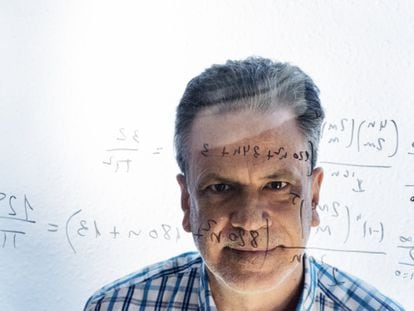What became of the most famous (and non-existent) mathematician of all time?
After almost 90 years, the secret collective behind the personality of Nicolas Bourbaki is still working on the task of writing the treatise ‘Elements of Mathematics’ and holding its celebrated seminar
/cloudfront-eu-central-1.images.arcpublishing.com/prisa/S3OCYLM6EZDTJGSXYC3IWDTNDM.jpg)
Few fictional characters have populated the archives to quite the same extent as Nicolas Bourbaki, the pseudonym under which a secret group of French mathematicians have been writing a general treatise on the discipline, Elements of Mathematics, over the course of the past 90 years. The group fleshed out their character with invoices for office supplies, sonnets supposedly penned by Bourbaki, an invitation to his daughter’s wedding and even an irate response from the American Mathematical Society to his attempt to become a member in 1950. Today, Bourbaki’s presence extends to the streets of Paris.
Anyone walking down rue Soufflot from the Pantheón towards the Luxembourg Garden will find themselves in the corner of Boulevard Saint Michel, where a commemorative plaque was raised in August by the Paris City Hall. It reads: “The group of mathematicians N. Bourbaki took shape for the first time on December 10, 1934, at the Capoulade Café, which occupied this location.” The idea of a commemoration was proposed by mathematician and author Roger Mansuy. It is an unusual adornment for a junction that has played host to a parade of fast food outlets, ever since the day when the founding members began to meet with the idea of writing a math textbook.
What has become of Bourbaki? Has the group met the same fate as the café where it was founded? Despite the assertion in 1998 by Pierre Cartier, the group’s secretary for decades, that “Bourbaki is dead,” the adventure continues. The most visible sign of life is the Bourbaki Seminar, which since its creation in 1948 has only been paused once, last year, at the height of the coronavirus pandemic. The idea is no less groundbreaking for its simplicity: sharing an outside view on the latest significant advances in geometry, analysis or numerical theory, to make them more accessible to the rest of the mathematics community.
Is it logical, in the context of current scientific practices, to spend so much time working on books in the knowledge that their impact is more and more limited?
These one-hour talks are the culmination of the lengthy work of understanding and summarizing – and sometimes transforming – the chosen theorems. The information is then condensed into a text of around 30 pages, which is distributed to the seminar’s attendees and later published in the mathematical journal Astérisque. The process does not come without risks: on occasion the entire way of thinking about certain mathematical objects has been changed forever and on others, fatal flaws have been uncovered in original published work. As of a few years ago, these Saturday meetings have been preceded by the Betty B seminar, created in honor of Bourbaki’s supposed great-granddaughter, with the goal of facilitating the understanding of some of the following day’s talks to master’s and PhD students.
After several online sessions, the seminar will return in all its glory with an in-person meeting on the first Saturday of October at its historical headquarters, the Institut Henri Poincaré. Four guest speakers will present what they have been working on night and day over the past few months: not their own work, but that of their colleagues.
It may come as a surprise to find such a willingness to share among those who associate Bourbaki with the image of an author of austere texts that changed the course of mathematics in the 20th century and – almost always in spite of itself – the way in which math was taught in schools. The influence of Bourbaki’s textbooks is considerably lighter today than it was 50 years ago, perhaps paradoxically because their style has become completely embedded among mathematicians: commonly used symbols like the empty set, or words such as injective, did not exist before Bourbaki invented them. Neither did the notion of organizing a text in independent statements, each followed by their demonstration.
Ninety years later, the group’s efforts to find the definitive presentation of the most useful elements of mathematics have not waned. In 2016, Bourbaki published a new text, its first in 20 years: Algebraic Topography. In 2019, a revised edition of the first volume of Spectral Theory was published, which will soon be followed by a previously unpublished second part focusing on one of the key findings in the theory of compact group representations: the Peter-Weyl theorem.
To write these treatises, the 10 active members of Bourbaki – who in theory remain secret – meet at a congress every summer. Following the methods adopted by the group’s founders they read aloud, word for word, the essays that the person responsible for each topic has meticulously prepared during the course of the year. Few sentences are read in one sitting without being completely transformed. At the end of the congress, the manuscript has been gutted. And then it is started afresh. Nothing is approved for publication unless unanimity is achieved. The process of publishing a new text can take over 10 years from start to finish.
Is it logical, in the context of current scientific practices, to spend so much time working on books in the knowledge that their impact is more and more limited? The members of the group are among the first to pose this question. They have discussions, they put forward arguments for and against, they practically never reach an agreement on anything, and yet they continue to write.
Javier Fresán is Hadamard Professor at the École Polytechnique in Paris.
/cloudfront-eu-central-1.images.arcpublishing.com/prisa/TO57NQTIZJBJJMY7OIQVXG5MGU.jpg)











































